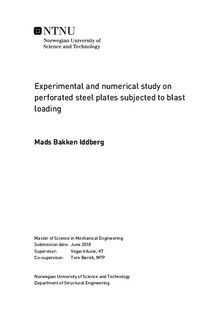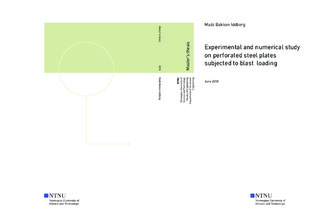| dc.description.abstract | This thesis investigates the behavior of deformable steel plates exposed to blast-loading, using experimental two numerical studies. The numerical work consists of a preliminary study and a numerical study with more realistic models. All experiments were conducted in the SIMLab Shock Tube Facility (SSTF) at the Norwegian University of Technology and Science (NTNU). The tested plates were made from 0.8 mm thick Docol 600DL steel with a 300 mm x 300 mm blast-exposed area. In total, four different plate-geometries were tested; two configurations containing square holes, and two configurations containing slits. The purpose of including holes and slits was to study crack propagation and fluid-structure interaction effects in the plates. The experimental results were documented through the use of two high-speed cameras, three-dimensional digital image correlation, laser scanning of the deformed plates and high frequency pressure measurements.
The objective of the preliminary study was to determine a test matrix to execute experimentally in the SSTF. The geometry of the tested plates, and the intensity of the applied blast load were determined in this part. The numerical models neglected fluid-structure interaction effects, and were all run solely in Abaqus Explicit. The loading was applied as idealized pressure-time curves. A benchmark for the numerical models in the preliminary study was created from the previous testing done at NTNU. The effects of element size, element type, boundary conditions, friction coefficients, and strain rate sensitivity were explored in separate parametric studies.
In total 13 plates were tested during the experiments. The four configurations were all tested at the nominal firing pressures associated with three distinct responses; complete failure, crack arrest, and deformation with limited to no cracking. The intended response was accomplished for all configurations except one.
In the numerical study with more realistic models, numerical solutions were compared to the experimental data for validation. This study includes pure Lagrangian models in Abaqus Explicit and models in Europlexus, which includes fluid-structure interaction. | en |

